Testimonies
Here is a selection of testimonies submitted to us via e-mail or Facebook, and originally published on our Hungarian-language website. These testimonies were selected and, unless stated otherwise, translated into English by Gwen Jones. To submit a story, please write to bertalan@ceu.edu.
2014. May 08., Thursday
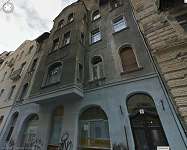
Late in her life, my grandmother had moved in with my Aunt Aranka on Paulay Ede Street. This later became a yellow-star house. In 1940, my grandmother went into hospital, where she died. I don’t know how old she was. Days in the yellow-star house were boring and pointless. A bunch of people locked up together. Only young boys, ladies and old people remained. All the men had been taken into forced labor service. They squeezed in as many families as they possibly could. What was funny was that this was a house with a double courtyard, and in the front courtyard, which was in better shape, there was a brothel on the first floor.
Every window of the brothel was papered over so that people knew that there were whores in there, not Jews. It was a closed courtyard, and the whores were not the streetwalker type, you couldn’t go downstairs in the evening; even if the women did go downstairs sometimes, the men never did. The brothel was run by a very nice French couple. The woman was called Josephine something or other. They had a bulldog, I remember that well. They were very nice, very liberal, and got on well with the residents, we even got on with the whores too, it wasn’t a problem. One of the whores lived with a Horthy detective. When she came down into the air-raid shelter in the basement, the detective came with her, but nobody minded. He didn’t think it was such a glorious thing to be living in a brothel, but there he lived and kept himself to himself. Generally, the detectives’ job was to track down Jews, and conspirators against the state. I don’t remember this man, but only know that he came down into the basement like anyone else, and never caused any problems, he was that sort of guy, and clearly the woman was also a good sort, you could feel it with them. The women were all just really nice. People in the yellow-star house were quarreling with one another and arguing all the time. Clairvoyants came, and Gypsies also came to swap stuff. My two female cousins swapped the contents of my aunt’s entire trousseau, which nobody ever wore, for a chicken. At some point they had made linen knickers and slips, and put them away in the chest. My generation never wore things like that, not even my aunt, I don’t think. They swapped the whole lot with the Gypsies. We always had delicious fried chicken. They criticized us in the house for giving too much stuff away in exchange for a chicken. People’s lives were ruled by idling, which I got sick of, pulled myself up and went out to work. I got a tip from Laci Vajda, a dentist who lived in the house, that there was work available on construction sites. One we cleared rubble from the gentry casino on the corner of Aréna [then Vilma királynő] Road and Gorkij [today Városligeti] Avenue. I loved working with the roofers. We climbed out of a four-story house, I sat on the joists and handed up the bricks. Nobody forced me to do this, I’m not scared of heights. Even today I still see that house opposite Szondi Street, where I sat on the roof, laying tiles. It was a very good group of people. The boss was a Jewish engineer, Mr. Markovics. I don’t know which engineering company he worked for, and I don’t know how he got a job like that, after the German occupation. They sent us all around the city, but mostly we were at the end of Gorkij Avenue, working with the remains of the gentry casino. My co-workers were very sweet Jewish girls. We all wore the [yellow] star. We had a really good time, lugging stuff about, taking joists, laying bricks, it was so much better than sitting in the yellow-star house conjuring up spirits because there was nothing else to do.
My father was on forced labor service but was allowed leave in Pest from time to time. Once he brought us some goose giblets but my two female cousins were too lazy to cook them, even though they stayed at home all day doing nothing; they stuck them in the refrigerator where they got full of maggots. That’s what crappy refrigerators were like in those days, you had to add the ice yourself. We could only go shopping during designated hours [under the Budapest curfew], but there was a crazy shortage of goods. There was nothing. There was “Sztójay” sausage, the worst liver pâté, and things that tasted even more terrible. [NB: In the wartime vernacular, poor quality foodstuffs were named after politicians blamed for the shortages. Thus the hard block of jam made from mixed fallen fruits was called “Hitler bacon.” Döme Sztójay was the antisemitic Prime Minister of Hungary from March to August 1944.] People took what they could get. Which was very little. There were no Jewish shops, they had been closed. You had to guess where Jews could go to shop. I don’t know where the others went shopping, I bought things at various place on the way home from work. I had to be home by 5 pm, and worked until 4 with the girls, who lived nearby. We went happily along Király Street, nobody bothered us, and on the way, we bought food and ate it. We didn’t have a ration ticket, or even a Jewish ration ticket, we bought what we could [the Public Supply Minister’s decree 108.500 K.M. of May 1, 1944, regulated the provisions Jews were entitled to, e.g. 100 grams of meat per week, 300 grams of sugar and cooking oil per month.]
The yellow-star house was at Paulay Ede Street 43, where my cousins lived. That’s where they grew up, that’s where their apartment was, but in the meantime both their parents died, and the two girls stayed on there. One of them, who is still alive today, was hidden by her prospective husband, who then didn’t become her husband after all. I stayed there with my other cousin. I was in one room with a very sweet old Jewish man, whose wife had been killed in the Vienna ghetto. There was also a couple named Dengler, who had a fish, game and poultry shop at the Buda-side bridgehead of Margit Bridge. They were very sweet, elderly people. It was good for my family that we were nominally together there, since they would have stuck total strangers in there too, however many. From November 1944, we had to go down into the basement air-raid shelter every night. The cannons were already thundering, and the Russians were already in Vecsés [19 km from Budapest], which we didn’t know, because Jews weren’t allowed radios. They had taken them away a long time ago [in April 1944]. There were no newspapers either, apart from the Arrow Cross paper, but we didn’t dare buy it and didn’t want to anyway. We knew nothing. This yellow-star house had an interior walkway around the courtyard, so it wasn’t like someone could listen to English radio [the BBC World Service]. There were house inspections, sometimes twice a night, and once I picked up a leaflet in English, and kept it in my bedside cabinet, but luckily it was never noticed. On November 9, 1944, they closed the gates of the yellow-star house on us. Before that, we weren’t locked in, there was just a curfew, but then they locked us in. They herded us downstairs at dawn, I went down in pajamas and long trousers. And that’s how I came home too, in the same pajamas I’d pulled on earlier. My walk was very unfortunate, since my father had brought me a brand new pair of black high-heeled shoes for all eventualities, and it was those I put on, which made my feet bleed during the march. The ladies noticed that I was limping. I didn’t know any of them. They sat me down, tore the shoes off me—which were by now bloody—and someone gave me a pair of heavy boots, which I tied onto my feet with string, because my feet were size 35. That’s how I walked, and came home in them too. I had a bonnet, a sort of pointed cap which you tied under your chin to wear in winter. I wouldn’t have worn it, because it wasn’t so cold, but I put it on right away. They didn’t give us time to get dressed properly. I threw some cheap jam and liver paste in a backpack. I didn’t meet anyone I knew, which even now I still don’t understand, because the entire street and house was forced onto the street. I just ambled along alone, and then the next thing was the death march [to the Hegyeshalom border crossing with Austria].
From the Centropa archive.

As long as my parents were alive, we spent the holidays with relatives—descendants of the Spatz family—at Lónyay Street 18/b, and which was a yellow-star house. The family of my grandfather’s sister, Mrs. Miksa Spatz (born Olga Spitzkopf), lived in the apartment. Her children were Edit and Katalin. Edit didn’t have children, and Katalin had a son at the very last moment, when she was 37 or 38, and his name was Péter Lusztig. Since Edit had been a child beauty, she was nicknamed Baba, Baba Spatz, that’s what they called her. Everyone loved her. She had two husbands, one died very young on forced labor service, they barely lived together, and the second also died later, but because he was ill. We went there a lot, and were together on the big holidays, Pessach and Yom Kippur, those sorts of family gatherings.
There was always one or two relatives there, who kept in close touch with other family members. The men always went from there to the synagogue, including my father. I know that on Yom Kippur they had to be on time, and when they signaled the end of the Yom Kippur, because we had been fasting too, we had tea and supper there. There was a strange habit at the end of the holiday, when the first star appeared and they blow the shofar, that’s when we had snacks, coffee with milk, a special ring cake and fruit. After the 24 or 26 hours of fasting, I ate whatever didn’t trouble my stomach. The men came from synagogue very hungry, and once we’d laid the table, out came the snacks. And about an hour or 90 minutes later, there was paprika chicken with rice, that was the supper. These holidays were celebrated for quite a long time, maybe up to the early 1970s, I think my children even came with us.
And then we spent a few weeks in the Swedish protected house at Pozsonyi Road 4. I don’t know exactly when we were there. From there we went to the ghetto. They herded us together one winter morning, sounding the bell for the whole house. We went on foot, and didn’t know whether we were being taken to [be shot at] the Danube, or somewhere else. We heard the dull sound of shooting from all around. But a child is not yet completely aware, and never has the sense of fear that adults have. And so we didn’t end up at the Danube, but in the ghetto. What should I say about that? We were starving, freezing, it was bad. It’s a bad memory, which completely broke my childhood in two. We were in a horrible basement, because there were no longer any free apartments, they ghetto was already full, I don’t know how many there were of us. No beds, no nothing, I remember there was an elderly lady concierge who had a large bed, and I slept in there with her. My parents slept somewhere on the floor. There were mattresses laid all around. Whether there was any heating at all, I don’t know. We were lucky, since the winter of 1944 was not particularly cold. We couldn’t leave to go outside, the whole territory was sealed off. It was possible to leave the house and stroll for a bit, but I don’t really remember that much. I only remember that I spent a lot of time with my parents. And we were glad when the day was over. We spent every day doing nothing. Listening to the bombings, shootings, and the news that came. I don’t think there were any other children there. Nor do I know whether they gave us anything to eat, or who. We had very little food. We survived in the ghetto thanks to the fact that Pest was already surrounded by the Russians, and so we avoided deportation. But we were always very hungry, and at the very last moment, on January 18, when the Russians arrived, they started handing out jam and things like that. When they opened the ghetto—we were there at the end of Akácfa Street by Király Street, the last house before the Terézváros church—and we broke through the hoarding planks to get home. The last days were pretty eventful, with Germans and Russians coming and going. My grandmother was somehow with us until the end, and was also liberated, but her diabetes was so advanced by then that her body gave up from the starvation, and she died a few weeks later. I remember they took her to the cemetery on a delivery cart. We got hold of a coffin, and that’s how she had to be taken to Rákoskeresztúr.
From the Centropa archive.
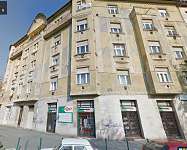
My grandmother and her family lived a few houses down from us, and we were very lucky because their house was designated a yellow-star house in the summer of 1944. Whoever was not Jewish was told they could move anywhere, in fact they received assistance too, and could go to live in an apartment that Jews had been forced to leave. But interestingly, in that house, many non-Jews stayed on. My mother and I moved into one of the rooms, and anyone left form our family came and moved in with us, so they didn’t have to live with strangers. And so in that apartment lived my grandmother, her three daughters (whose husbands were on forced labor service), and all their children, plus my uncle Aladár, his mother-in-law, wife, and their small child, whose biological father they never saw because when the child was born, he’d already been on forced labor service for a long while. I was there together with my mother. There were 12 of us in a three-room apartment, plus one woman we did not know.
My mother and her younger sister Piroska survived, although in 1944, in the yellow-star house, they received a summons to the Óbuda brick factory, and off they went. They took their coats, walking boots, and something to eat. My mother was not a practical person. She was terrified of every action, but her sister was a very resourceful type. Later they said that there was such chaos in the brick factory, such a senseless amount of women and old people, that they couldn’t fit them all on the wagons, it was mayhem. My aunt said to my mother, “Hey, let’s get out of here.” My mother didn’t dare, but my aunt insisted, and so they escaped and came home to the yellow-star house. After that we were terribly afraid that one of the neighbors would denounce them. But nobody did. And that’s how they missed the wagons destined for Auschwitz. So only my mother’s family survived. Where we lived in the yellow-star house, there was a very kind Christian lady whose 15-year-old son who, how should I put it, expressed great attraction towards me. And for days this guy would go to our old abandoned apartment and put as much as he could of my grandmother’s stored food from the larder into a backpack and bring it to us for as long as entry into the ghetto was still possible. He brought us lentils, split yellow peas, onions, potatoes, everything we had stored under my grandmother’s supervision in the summer of 1944, because meals had to be so carefully planned. This was a huge help, since in practice it meant that although we were terribly hungry, we didn’t starve, unlike many older people who did die of starvation there. We couldn’t stay in that apartment for very long, because when the siege and bombing of Budapest began, one of the bombs hit the house next to us on Kisdiófa Street 5. As a result, the stairwell of Kisdiófa Street 3 came away from the wall. Everyone was terrified and the entire house moved downstairs into the basement. In fact the entire ghetto lived in basements. There was no other way. We took what we could with us down into the basement, and although the other staircase remained in tact, nobody dared to go upstairs because of the constant bombing, cannon fire and shooting.
From the Centropa archive.
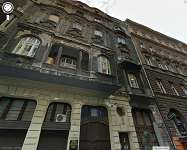
Since my dad was working in the match factory, which was a Swedish-owned company, my mother received a Swedish protection letter. First they were in the yellow-star house at Csáky Street 3, which was a place of worship. Later, when the protection letters were in circulation, Aunt Jolánka and my mother went to the Swedish protected house on Hollán Street. But one day the Arrow Cross came at the beginning of November, and cleared the house out. They took everyone to the brick factory and from there to Bergen-Belsen. My mother also ended up in Bergen-Belsen, as did her parents.
From the Centropa archive.

One of my father’s good friends had a basement facing the street at Hollán Street 3, which is where we were later in the yellow-star house. They lived on the fifth floor and he was also a chemist who specialized in cyanide. At that time, Budapest apartments were full of bedbugs, and it was simply impossible to get rid of them. People got cyanide pest control in every year, but there were still bedbugs everywhere. You had to leave the apartment, which was hermetically sealed, they pumped in the cyanide and 22-24 hours later, they aired the place, and then you could go back in and clean up. On top of this, every week my mother took all the beds apart with the maid, since those old-type beds could be disassembled. She sprayed them with petrol and cleaned out all the holes and cracks with pieces of wire, took the pictures down from the wall, so it was awful work, and still there were bedbugs. It was impossible to get rid of them right up until the end of the war. My father’s friend’s workshop and storage space were in the basement of Hollán Street 3, and during air raids I had to walk over there from school. It wasn’t very far, but I can’t say how frightened I was on the way!
I told my father that the Germans had arrived. He called one of his friends on the telephone who confirmed to him that yes, they really had arrived. We were really nervous until that evening, when my mother’s family turned up. And then everything moved like lightning: they disconnected the telephones in Jewish apartments, you had to return your radio set, and very soon, move into a yellow-star house. Paulay Street 12 did not become a yellow-star house, and so we had to leave. In school they quickly issued certificates from the second class, because this was a shortened academic year and after that there was no more teaching. I remember things started to go very bad when my father packed up his pistol—it turned out he had one—and some Communist literature, tied them up in a parcel and we went to the Chain Bridge to throw it into the Danube. We lived with my father’s friends on the fifth floor in the yellow-star house at Hollán Street 3. There was also a couple living in the bedroom who’d also been forcibly moved, like us. In the yellow-star house, apart from having to wear the yellow star, there were also regulations about when we could go out into the street. We couldn’t work, and everyone lived from their savings. We children played with the other children in the house. Since we couldn’t go outside onto the street, we always played in the stairwell. And then one day they came to take my parents away. The Gestapo took them some time in August. I went upstairs and two guys—just like in the films, wearing caps and mackintoshes—were leading my parents away. I tried to obstruct them, these two people hadn’t done anything wrong, and they just swept me aside. And then, just like in the films, a little car took my parents away to the Majestic hotel.
From the Centropa archive.
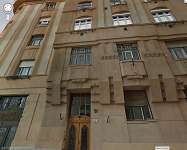
First we lived in a Jewish [yellow-star] house, and brought our relatives over to live with us, one of my aunts, Jolán Schlesinger, who later became Mrs. Richárd Schwarz. Once we had a two-room apartment with a bathroom, we brought another family over. This was at István Road 40. The other family had four members, and the families had one narrow room each. Then Jolán Schlesinger and family moved out, but I don’t know where. They survived the war. Later, with my older sister’s help, under Swiss protection, we moved into Katona József Street 41, where other families were already living together in one room. That was already too much, and from there we could see the atrocities at the Danube, where my uncle and cousin, among others, were killed: they shot József and Gyuri Natonek into the Danube. My older sister saved my parents by going up to one of the Arrow Cross man who, it appears, understood why she was sad. My parents were called up from the basement, and went back to the protected house, where we met again, I returned there myself a bit later.
From the Centropa archive.
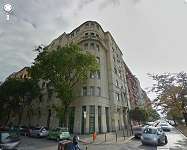
In the ghetto, I learned that my Aunt Etel and her daughter-in-law Manci, together with her ten-year-old grandson Bandi, were staying in a basement at Wesselényi Street 4. Uncle Ignác, Etel’s husband, had been snatched away; we don’t know which death camp he was killed in. Aunt Etel and remaining family were forced to move into the yellow-star house at Sziget Street 40. They were sent to the Óbuda brick factory too, but the old people and parents were allowed to go back home. They could have returned to their apartment, but had moved into the ghetto two months earlier, and their apartment was there on the fourth floor, where the daughter-in-law sometimes went to cook, until she noticed that the roof of the house opposite was higher than usual, and was crumbling to pieces.
A Russian bomb had fallen on it. The Germans had installed automatic guns on countless rooftops at the junction between Wesselényi Street and the ghetto, which they used to try to dispel the Russian military airplanes which appeared regularly every day. They dropped small-sized bombs which regularly caused varying damage not to the air-defense guns, but to the neighboring houses. In fact Jews didn’t have to move out from Sziget Street 4-6, three or four Jewish families stayed behind. One of whom, the wife of a cobbler, seeing my distress, offered me schnitzel made with powdered egg. The house wasn’t designated as a yellow-star house. This was thanks to the vice-concierge’s son, who was an Arrow Cross party activist. They didn’t take over the apartment vacated by my father, we didn’t suffer Arrow Cross raids, and when we had to move, the residents said goodbye. This was exceptional, a unique case in the history of the Arrow Cross rule in Budapest. Our preparations were very chaotic. First we used up Aunt Etel’s limited food reserves. Her last “hobo” apartment before they had to move into the ghetto was in the Palatinus house at the end of Sziget Street. She asked us to bring her the things she’d left behind in a car. I filched a piece of elbow piping so there was no more impediment to laying a fire in the oven in the maid’s room. We dug out the stamp collection which had been hidden underneath a pile of coal in the coal cellar, and one part of my deceased mother’s jewelry. The other half was hidden by a dear friend, Mrs. Pilát, who gave it back in one piece.
From the Centropa archive.
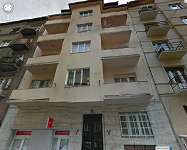
I never experienced any antisemitic incidents before 1944, when someone punched me on the street. We were very afraid in 1944 after the Arrow Cross took over, and took the Jews to the Tattersaal racing track. When the Arrow Cross went from house to house, I remember being very frightened.
And then we escaped this in the house, because my grandfather had a false paper that said he had been condemned to death during Béla Kun’s rule. He showed this to the Arrow Cross and they decided that we could stay at home. The others from the house returned two days later. They didn’t take us away from the house, and again this was due to my grandfather’s genius, because he acquired a fake Swiss protection passport, of course it was perfectly clear that the stamp on the passport was fake. So he made a photocopy of it, and I remember that the whole family’s name was written on it: him, my grandmother, my mother and me, and we went to the corner of Rákóczi Road and the Boulevard where there was a public notary. And he had the photocopy certified, and from that point on we presented our certified copy of a fake document. My grandfather was a very, very refined person. The house on Szövetség Street was declared a Jewish house. I think the majority in the house was Jewish anyway. Although the area around it was not a Jewish area, the house was designated a Jewish house. That’s where we were during the war. And I also remember that on the ground floor there lived someone called Keresényi or something like that, who bought me ice cream from the cake shop opposite, because Jews couldn’t go into cake shops. After the Arrow Cross took over, we had to leave the house: there was some office on Pozsonyi Road and that’s where they designated a protected house for us at Tátra Street 29/b. The apartment wasn’t that crammed full. I don’t remember who we lived with. We’d go down into the basement where there might have been a carpenters’ shop and that’s where we were during the bombings. We cooked there together. I remember eating a bean stew where, instead of using bicarbonate of soda to soften the beans, someone had added anti-moth powder by accident. But we ate it anyway. And that’s where we were liberated, but the Arrow Cross were already going from house to house and taking the Jews to the Danube banks. If the Russians hadn’t arrived two days later, we would have died there too. Countless people died in the Holocaust. Forty from my family. In the family tree I made, there are over 200 hundred names, and I made the tree so my children would know where they come from. I worked on it for years, and when I was in Israel I tried to supplement the information. It’s now finished.
After the war, we went back to Szövetség Street. Some things remained in our apartment, some things had gone. Most of the furniture survived. But my Märklin railway had disappeared. I remember that we didn’t have anything to eat in 1945, and there was a family in the house called Wintermantel, who were jewelers and Christians. They had two children, and I made a deal with them: I’d give them my Märklin railway in exchange for food. But when I went to look for it, I saw it had been taken, it was gone. So the deal was off.
From the Centropa archive.
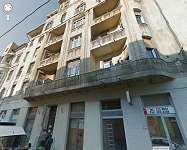
In June 1944, we moved from Munkás Street to the yellow-star house. We had to leave our apartment by 10 pm. Whoever couldn’t find a place to live, the congregation tried to find them a place in one of the yellow-star houses, in other words an apartment. We got up at dawn, got dressed, and then a car came for us, and then we came here, to the yellow-star house at István Road 20, on the fourth floor, no. 50-51. I should also mention our concierge, a lady around 57 years of age, she was a fragile woman who took on a 5-story house with 60 apartments during the war years, and so she had lots to do as concierge. It is thanks to her, Auntie Margit Keszte, that the affairs of the entire house were sorted out, and so we never had any problems, and there were so many of us living there. Lots of families lived in those 60 apartments, at least 300 of us. There were many old people and families too.
I am amazed that this fragile little woman managed to do so much, and led the house in such a smart way, at the price of numerous battles. It wasn’t enough for Auntie Margit to look after us, she also had to conceal one of the residents, who was an actual baron, and who produced protection letters on the quiet. They lived on the third floor. He produced them there, there were people hanging off the door-handle, you couldn’t even close the door before the next person arrived. He produced these protection passports and letters not only for the residents, but for others outside the house too. The blinds were pulled down, and all the decent left-wing people met there, that’s where they held meetings. The baron belonged to Wallenberg’s group, and after the war, he had to leave Hungary immediately, without his family, otherwise they would have taken him away. So a few months after we came home in 1945, he left without his family. Auntie Margit’s son Lajos, who was a cabinet-maker, made a large three-door wardrobe. You could go through a wallpapered attic door into the fifth-floor apartment. And that’s where they placed the large, heavy, three-door wardrobe. They stuffed heavy rags underneath it, and Lajos fixed it so the back panel could be opened. So you could go through the wardrobe. He opened the wardrobe, at the back they removed the panel, so food could be handed over. That’s where we hid when the Arrow Cross came. The children in the house really loved Auntie Margit, and we always hung around her apartment. We had to accompany residents up the stairs so that the elevator wouldn’t break down. We were all given tasks. In 1944, I already had an elevator operator’s certificate, because Auntie Margit taught us how to work the elevator so that we wouldn’t have to call the mechanic out so often. We accompanied everyone upstairs and then called the elevator down. But Auntie Margit herself was given orders when the Arrow Cross came, when she looked around and said, children, into the elevator. Underneath the elevator was a 1.5 meter high box which went down into the elevator shaft. The back of the box had been taken out so we children could be sat in there. They said: this elevator is moving slow. We were suffocating but shut our mouths so that nobody noticed anything. I have to say, you didn’t have to think, for the whole time there you just acted on instinct. There was always a young Wehrmacht soldier standing at the front gate, whom we called Matyi. He just stood there, not admitting any strangers, I don’t know what his orders were. When we came back, we looked for him and were told that soon after we were taken away, he had to leave too, and he fell in the siege of Budapest. I was really sorry for him, because he was only 21. And he was such a nice boy. Diligently, he came to work every day and stood there from morning until night, and no Arrow Cross people could enter.
From the Centropa archive.

For eleven months we went from one house to the next, with ever diminishing luggage. We lived on Alpár Street, then on Nefelejcs Street, on Pozsonyi Road in a protected house, and from there they took us to an Arrow Cross house on Teleki Square, and then back to Pozsonyi Road. We were often hungry and thirsty. We were terribly thin. Weeks passed when we didn’t even have drinking water, and not even the toilet worked, and there were 40 people in one apartment: this was on Pozsonyi Road. They brought wounded people in too, one had been shot through the kidneys and bled to death there. We stepped over the congealed blood in the middle of the room. Jews were not allowed to go outside, there was a curfew in force. The houses were closed up and guarded by armed men, both yellow-star and protected houses, this was in December 1944.
From the Centropa archive.